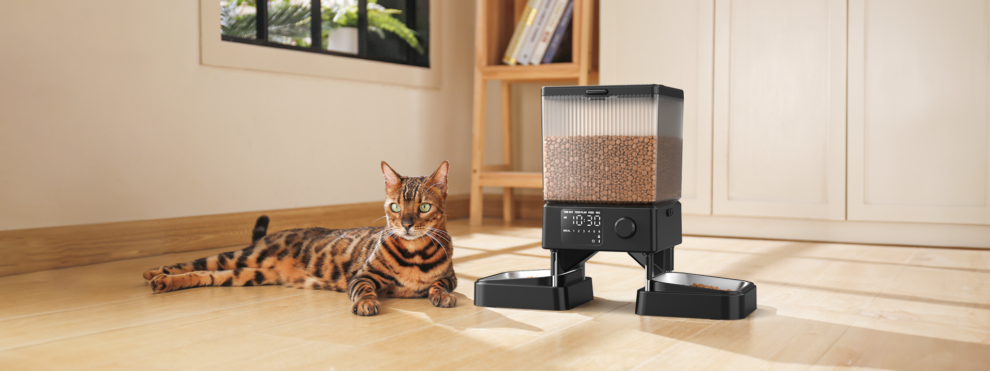For pet owners, ensuring that their feline friends are well-fed and happy is a top priority. However, balancing a busy lifestyle with the need to maintain regular feeding schedules can be challenging. This is where timed cat feeders come into play. These devices can dispense food at predetermined times, ensuring your cat gets fed even when you’re not home. But when choosing between a DIY solution and a commercial timed cat feeder, which is the best option for you? This article will delve into the pros and cons of both choices to help you make an informed decision.
Table of Contents
Understanding Timed Cat Feeders
Timed cat feeders are designed to dispense a specific amount of food at set intervals. They come in various forms, from simple mechanical models to sophisticated electronic ones with programmable features. The primary goal of these feeders is to automate feeding schedules, providing convenience for pet owners and consistency for pets.
DIY Timed Cat Feeders
Creating your own timed cat feeder can be an appealing option for those who enjoy DIY projects and want a customized solution for their pets. Here are some advantages and disadvantages of making a DIY timed cat feeder:
Pros:
- Customization:
- You can design a feeder that fits your cat’s specific dietary needs and your home’s aesthetics.
- Customization allows for unique features, such as special portion sizes or additional compartments for treats.
- Cost-Effective:
- DIY solutions can be more affordable than commercial feeders, especially if you have some of the necessary materials on hand.
- You can save on costs by repurposing household items.
- Satisfaction:
- The process of building a feeder can be rewarding and fulfilling, giving you a sense of accomplishment.
- It allows you to use your creativity and problem-solving skills.
Cons:
- Time-Consuming:
- Building a DIY timed cat feeder can be time-intensive, requiring a significant amount of effort and patience.
- It may take multiple attempts to get the design and functionality just right.
- Technical Challenges:
- Ensuring the feeder dispenses the correct amount of food at precise times can be technically challenging.
- If you’re not mechanically inclined or lack the necessary skills, the project could become frustrating.
- Reliability:
- Homemade feeders may not be as reliable as commercial ones, especially over long periods.
- There is a risk of malfunction, which could lead to missed feedings or overfeeding.
Commercial Timed Cat Feeders
Commercial timed cat feeders are professionally designed and manufactured, offering a wide range of features to cater to different needs. Here are some of the advantages and disadvantages of opting for a commercial feeder:
Pros:
- Convenience:
- Commercial feeders are ready to use right out of the box, saving you time and effort.
- They come with user manuals and customer support, making setup and troubleshooting easier.
- Reliability:
- These feeders are designed to be reliable and consistent, reducing the risk of malfunctions.
- Many models have backup batteries or power sources to ensure continuous operation.
- Advanced Features:
- Commercial feeders often come with advanced features such as programmable schedules, portion control, and even smartphone connectivity.
- Some models include voice recording capabilities, allowing you to call your cat to meals.
- Variety:
- There is a wide range of commercial feeders available, catering to different budgets and specific needs.
- You can choose from basic models to high-tech versions with multiple functions.
Cons:
- Cost:
- High-quality commercial feeders can be expensive, with prices varying based on features and brand.
- While they offer convenience, the initial investment can be significant.
- Limited Customization:
- Commercial feeders offer less flexibility in terms of design and features compared to a DIY solution.
- You may have to compromise on certain aspects if your needs are highly specific.
- Dependency on Technology:
- Advanced models rely heavily on technology, which can sometimes fail or require regular maintenance.
- If the feeder relies on Wi-Fi or a smartphone app, connectivity issues could disrupt feeding schedules.
Which Option Is Best for You?
Deciding between a DIY and a commercial timed cat feeder depends on several factors, including your budget, technical skills, and specific needs.
Consider a DIY Timed Cat Feeder if:
- You enjoy hands-on projects and have the time and patience to build your own feeder.
- You have specific customization requirements that commercial feeders can’t meet.
- You are looking for a cost-effective solution and have some of the materials available.
Opt for a Commercial Timed Cat Feeder if:
- You prefer convenience and reliability with minimal effort.
- You want advanced features and are willing to invest in a high-quality product.
- You need a solution that offers consistent performance and customer support.
Conclusion
Both DIY and commercial timed cat feeders have their unique advantages and drawbacks. Your choice should align with your lifestyle, budget, and your cat’s needs. If you enjoy DIY projects and want a customized feeder, building your own could be a rewarding experience. However, if convenience, reliability, and advanced features are your priorities, a commercial-timed cat feeder might be the better option. For a range of high-quality commercial feeders, consider exploring Oneisall’s collection of timed cat feeders to find the perfect fit for your feline friend.




Add Comment